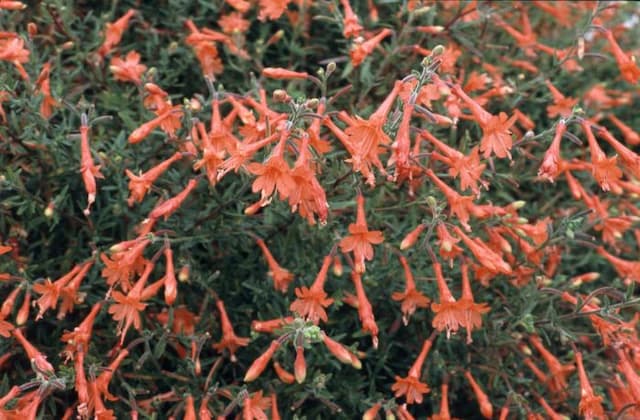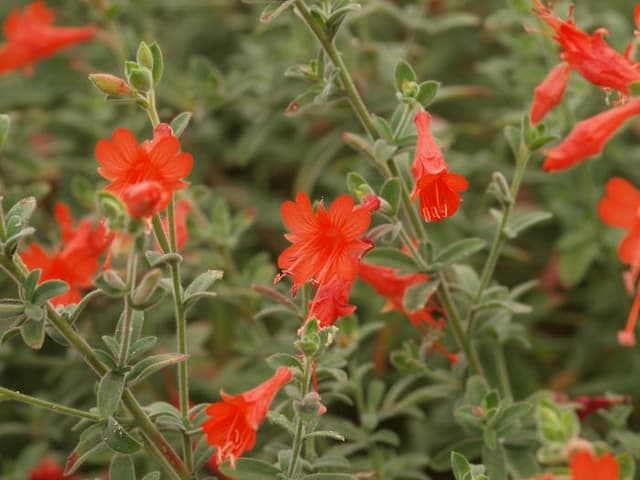Fuchsia Fuchsia 'Corallina'

ABOUT
The Fuchsia 'Corallina', is a stunning plant known for its highly decorative flowers and lush foliage. Its blooms are particularly eye-catching, characterized by their elegant, pendulous form and vibrant coloration, which often features a beautiful blend of purples and pinks. The petals are slender and gracefully elongated, with a softer, paler inner layer that encapsulates the bolder, brighter outer petals. This striking contrast is further accentuated by the long, protruding stamen that emerges from the center, adding an extra hint of color with a touch of yellow or pink. The foliage of the Fuchsia 'Corallina' consists of dark green leaves that have a slightly glossy appearance and are often lance-shaped with a gently serrated edge. The leaves are arranged oppositely along the stems, creating a lush, bushy appearance. The stems are sturdy, supporting the weight of the flowers, and may have a slight reddish tint that complements the vibrant blooms. Fuchsia 'Corallina' is a favorite among gardeners and plant enthusiasts for its ornamental qualities and its ability to add a splash of vivid color to hanging baskets, containers, and garden borders. Its stunning flowers hang like delicate lanterns and are known to attract hummingbirds and other pollinators, adding not just beauty but also a dynamic element to any garden space where it is grown.
About this plant
 Names
NamesFamily
Onagraceae.
Synonyms
Coral Fuchsia, Lady's Eardrops, Earring Flower.
Common names
Fuchsia 'Corallina'.
 Toxicity
ToxicityTo humans
Fuchsia is generally considered non-toxic to humans. Consequently, ingesting parts of the Fuchsia plant typically does not lead to poisoning or severe adverse health effects. However, it is always recommended to exercise caution and avoid consuming plants that are not explicitly meant for human consumption, as individual sensitivities can vary.
To pets
Fuchsia is generally regarded as safe for pets, with no significant toxic effects reported in dogs, cats, or other animals. Therefore, ingesting this plant is unlikely to cause poisoning in pets. However, each animal's sensitivity may differ, and it is prudent to prevent pets from consuming non-food plants as a precautionary measure.
 Characteristics
CharacteristicsLife cycle
Perennials
Foliage type
Deciduous
Color of leaves
Green
Flower color
Mixed
Height
1-2 feet (30-60 cm)
Spread
1-2 feet (30-60 cm)
Plant type
Shrub
Hardiness zones
9
Native area
Central America
Benefits
 General Benefits
General Benefits- Aesthetic Appeal: Fuchsia 'Corallina' adds a splash of vibrant color to gardens with its attractive and distinctive pink and purple flowers.
- Attracts Pollinators: The plant is known to draw in bees, butterflies, and hummingbirds, contributing to the pollination of your garden.
- Versatility: It can be grown in pots, hanging baskets, or in the ground, making it a flexible choice for different garden layouts.
- Shade Tolerance: This fuchsia variety performs well in partially shaded conditions where many other flowering plants might not thrive.
- Long Blooming Season: It provides a long season of blooming, from late spring to early fall, ensuring continuous color in the garden.
- Low Maintenance: Fuchsia 'Corallina' generally requires minimal care, making it a suitable plant for gardeners of all levels of experience.
 Medical Properties
Medical PropertiesThis plant is not used for medical purposes.
 Air-purifying Qualities
Air-purifying QualitiesThis plant is not specifically known for air purifying qualities.
 Other Uses
Other Uses- Fuchsia 'Corallina' flowers can be used as natural dyes, where the petals impart gentle hues to fabrics and papers.
- The plant can serve as a nectar source for hummingbirds and butterflies, making it ideal for pollinator gardens.
- Fuchsia 'Corallina' can be used in hanging baskets to create dynamic vertical gardening displays due to its trailing growth habit.
- Its vibrant blossoms can be used in garnishing dishes, adding a splash of color to salads and desserts.
- The plant's stems and leaves can be incorporated into floral arrangements or bouquets for a touch of unique texture and form.
- Fuchsia 'Corallina' can be trained to grow as a small ornamental tree for patio and container gardening.
- The flowers can be used as a natural indicator for pH balance, changing colors based on the acidity of the substances they come in contact with.
- Leaves from the Fuchsia 'Corallina' can be used in crafting, such as pressing for botanical art or as stencils for creative projects.
- The plant can act as a "living fence" when grown densely, providing privacy and enhancing the aesthetics of outdoor spaces.
- Cuttings from Fuchsia 'Corallina' can be propagated easily, making it a sustainable choice for gardeners who wish to share plants with friends and community.
Interesting Facts
 Feng Shui
Feng ShuiThe Fuchsia is not used in Feng Shui practice.
 Zodiac Sign Compitability
Zodiac Sign CompitabilityThe Fuchsia is not used in astrology practice.
 Plant Symbolism
Plant Symbolism- Elegance: The pendulous blooms of the Fuchsia suggest refinement and grace.
- Gentility: Its delicate flowers have historically been associated with noble and gentle behavior, particularly in Victorian flower language.
- Confiding Love: Giving someone a Fuchsia can communicate trust and a confiding kind of love.
- Amiability: The easy-growing nature and cheerful flowers of the Fuchsia symbolize a friendly, approachable spirit.
- Taste: Fuchsia blooms represent good taste due to their ornate and aesthetically pleasing appearance.
 Water
WaterFuchsias, including the variety 'Corallina', prefer consistently moist soil, so it's important to water them regularly. During the growing season, water the plant thoroughly whenever the top inch of the soil feels dry to the touch. This might mean watering once or twice a week, depending on climate conditions and the size of the plant's container. Ensure that the fuchsia receives roughly one to one and a half gallons of water each time to saturate the root zone. In hotter temperatures or if your plant is in a particularly sunny spot, it may require more frequent watering to prevent wilting.
 Light
LightLady's eardrops flourish in bright, indirect light or partial shade conditions. Place your fuchsia where it will be shielded from the harsh afternoon sun, especially in warmer climates, as too much direct sunlight can scorch the leaves. An ideal spot might be a location with morning sun and afternoon shade or under the dappled light of a tree canopy. Indoor fuchsias should be situated near a window that offers similar light conditions.
 Temperature
TemperatureLady's eardrops thrive in cool to moderate temperature ranges. Ideal temperatures for fuchsias are between 55 and 75 degrees Fahrenheit, though they can survive short periods outside of this range. They are not frost-hardy and should be protected or brought indoors when temperatures approach the freezing mark of 32 degrees Fahrenheit. On the upper end, fuchsias can struggle with temperatures exceeding 80 degrees Fahrenheit and may require shading and increased watering to stay healthy.
 Pruning
PruningPruning is essential for Lady's eardrops to maintain a bushy form and encourage prolific flowering. After the last frost in spring, prune back about two-thirds of the plant to promote sturdy, branching growth. Throughout the blooming period, regularly deadhead spent flowers to enhance further blooming. At the end of the flowering season, you can lightly prune the plant again to keep it tidy. The best time for major pruning is early spring, but light pruning and deadheading can be done throughout the growing season as necessary.
 Cleaning
CleaningAs needed
 Soil
SoilThe best soil mix for Fuchsia 'Corallina', commonly known as Lady's Eardrops, should be rich, moist, well-draining, and slightly acidic to neutral with a pH range between 6.0 and 7.0. An ideal mix can be created using one part loam, one part peat moss, and one part sand or perlite to ensure proper drainage.
 Repotting
RepottingLady's Eardrops plants should be repotted annually, ideally in the late winter or early spring before the onset of new growth. This helps to rejuvenate the soil and provide space for expanding roots.
 Humidity & Misting
Humidity & MistingLady's Eardrops thrive best in high humidity conditions, preferably around 60-70%. If grown indoors, this might require the use of a humidifier or regular misting to maintain optimal humidity levels.
 Suitable locations
Suitable locationsIndoor
Provide bright, indirect light and high humidity.
Outdoor
Use semi-shaded spot, shelter from strong winds.
Hardiness zone
10-11 USDA
 Life cycle
Life cycleFuchsia 'Corallina', also known simply as fuchsia, begins its life cycle as a seed, which upon germination, grows into a small seedling. The seedling stage is characterized by the development of a root system and the first set of true leaves. As the plant enters the vegetative stage, it grows stems and foliage, becoming a bushy plant. During the flowering stage, fuchsia produces distinctive pendulous flowers with a combination of vivid colors, typically in the summer. After pollination, often by hummingbirds or bees, the flowers develop into small, edible fruit that contain seeds, thereby completing the reproductive cycle. As a perennial, fuchsia can then enter a period of dormancy, particularly in colder climates, before resuming growth in the following growing season.
 Propogation
PropogationPropogation time
Spring-Early Summer
Fuchsia 'Corallina', more commonly known as Fuchsia, is best propagated through softwood cuttings. The ideal time to take these cuttings is in the spring when the plant is actively growing. Softwood cuttings are taken from the new growth that is just beginning to harden but is still flexible. The cuttings should be about 2 to 4 inches (5 to 10 centimeters) long and cut just below a leaf joint or node. Remove the leaves from the lower half of the cutting and dip the cut end into a rooting hormone to encourage quicker root development. The cutting is then planted in a moist, well-draining soil mix. The plant should be kept in a warm environment with indirect sunlight until roots have developed, which typically takes about three to four weeks.









